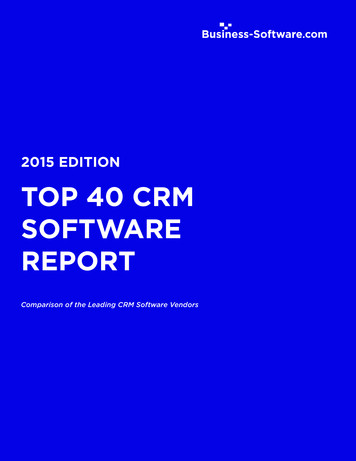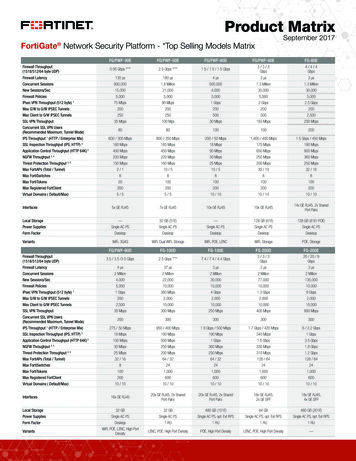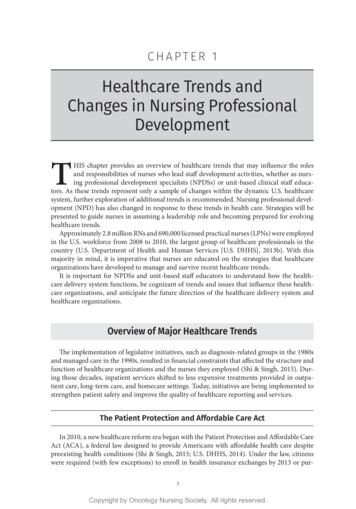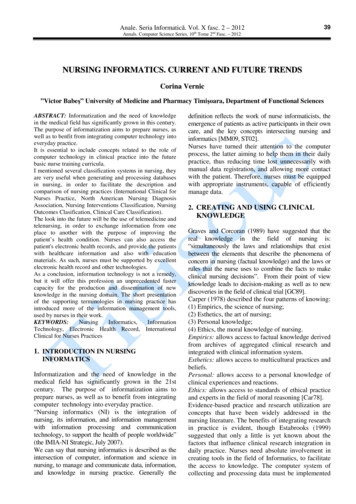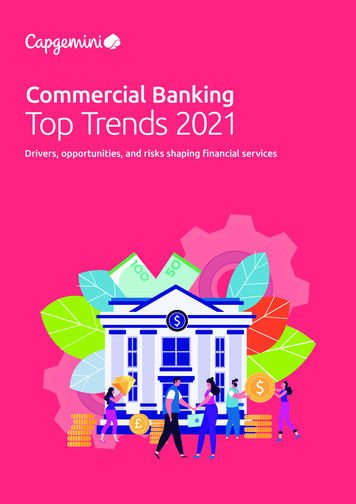
Transcription
Commercial BankingTop Trends 2021Drivers, opportunities, and risks shaping financial services
TABLE OFCONTENTSExecutive Summary 4Trend 01- Integrating banking within corporate client workflow6Trend 02- Banks use cognitive technologies to strengthen credit risk management8Trend 03- As FinTechs cater to SMEs, incumbents rethink existing business models10Trend 04- Banks transform CX with a focus on digital12Trend 05- Investment in FinTech solutions boosts digital business lending withinpandemic environment 14Trend 06- Banks identify new ways of doing business to continue seamless customersupport16Trend 07- Banks need value-added services to meet the expectations of small-businessclients 18Trend 08- Commercial banks are turning to Open X to create an experiential and agilebusiness model 20Conclusion 22Ask the experts 23
Executive SummaryLessons learned help us focus on the futureWhen we published Top Trends in Commercial Banking 2020 (in Q4 2019), few could foresee thata global health crisis would disrupt - and in some cases transform - so many industries. Now, theuncertainty of 2020 is setting the global tone for the immediate future in the financial services industry.So it is no surprise banks are laser-focused on business resilience, emphasizing both financial andoperational risks. The need to adapt quickly to new normal conditions through virtual customerengagement is clear.Customer centricity continues to drive commercial banks’ solution designs. And, the pandemiccompelled products that deliver immediate client value - quick digital onboarding, seamless lending,and support for small and medium-sized enterprises (SMEs). The onus is now on banks to go to marketmore quickly, which requires the implementation of intelligent processes and integrating corpoartes’enterprise resource planning (ERP) systems with banking workflows.To achieve go-to-market agility, banks across the globe are investing in and collaborating withFinTechs. Many of these partnerships are focused on boosting digital lending and providing seamlesssupport to anxious small-business clients in need of assurance.With newfound impetus for FinTech collaboration, commercial banks have picked up their step on thepath toward OpenX. COVID-19 made it evident that survival during turbulence is manageable throughcollaboration with ecosystem players. Hence, banks are transforming their businesses from a productled, siloed model to an experiential and agile plan.As we discuss the top industry trends for 2021, we have highlighted the business impact each of thesetrends is on course to make and the relative priority of their adoption by banks worldwide.4Top Trends in Commercial Banking: 2021
Banks use cognitive technologies to strengthen creditrisk management3As FinTechs cater to SMEs, incumbents rethink existingbusiness models4Banks transform CX with a focus on digital5Investment in FinTech solutions boosts digital businesslending within pandemic environment6Banks identify new ways of doing business tocontinue seamless customer support7Banks need value-added services to meet theexpectations of small-business clients8Commercial banks are turning to Open X tocreate an experiential and agile business modelSignificant228HighIntegrating banking within the corporate workflow63Medium1Relative priority of adoption (2021)Exhibit 1: Top Commercial Banking trends 2021- Priority matrix4571MediumHighSignificantBusiness impact (2021)Source: Capgemini Financial Services Analysis, 2020.Priority of adoption refers to the urgency of adopting a particular trend to maximize value creation in2021. This is a relative rating based on the identified trends for a normal commercial bank operating inthe current environment.Business impact represents impact of an identified trend on the commercial bank’s business in2021. The impact could be on customer experience, operational excellence, regulatory compliance, orprofitability.This represents the view of Capgemini analysts for a hypothetical bank working in the current operatingenvironment: Low interest rateOperational disruption due to COVID-19High competitive environment and increased focus on customer centricity due to new-age playersOperational cost overruns and high capital lock-insUncertain regulatory environmentThis will vary for a specific bank depending on their business priorities, geographic location, and severalother factors. For specific requirements, please contact banking@capgemini.com5
Trend01Integrating banking within corporateclient workflowCommercial firms are integrating banking applications within clients’enterprise resource planning (ERP) systems to automate and streamlinefinance and treasury processes for smoother data interchange anddeliver financial services at the point of need.ContextTraditional treasury and account management systems cannot keep up with changing organizationalneeds within today’s dynamic business landscape. As corporations grow through global expansion or acquisitions, their treasury and accountingsystems become more complex, and they add on multiple banking relationships.– The result? Routine financial transactions become more time-consuming as corporates connectwith multiple platforms to manage account payables and receivables and obtain a complete viewof their liquidity positions. Pandemic conditions have exacerbated these challenges. A global survey of more than 250 treasurersand CFOs revealed that 64% are worried about liquidity, 14% are concerned about an increase incybercrime, and 6% have trouble making payments.1Catalysts As the significance of the treasury function in firms’ business strategies grows, the importance ofeasy access to complete financial data also increases. In an uncertain economic environment, corporate clients are also looking for better cashmanagement solutions from their banks.2– Operating in a capital-intensive industry severely impacted by the pandemic, German car partsmaker ZF Group looked to its banks for solutions to effectively manage liquidity and fixed costs.3 Technologies such as application programming interfaces (APIs) and automation are enablingbetter connectivity and straight-through processing across diverse platforms to support integrationbetween banking and ERP systems.In a nutshell Supported by APIs, commercial banks are integrating banking applications within clients’ ERP,treasury management, and accounting systems. This enables corporates to manage banking andpayment transactions within their internal environment without logging into multiple platforms fordifferent functions. Apart from convenient and secure transactions, this capability helps clients with real-time payments,visibility over their financial situation, better standardization, and fewer errors. With fewer manual operations required, staff can focus on more strategic and value-adding tasks. Banks are rolling out integration initiatives with specific ERP systems.1236Treasury Management International, “Infographic – Treasury Challenges: Covid-19,” accessed October 2020.Greenwich, “Challenges for European Companies Create Opportunities for Corporate Banks,” March 3, 2020.Deutsche Bank, “Managing treasury in times of COVID-19,” April 23, 2020.Top Trends in Commercial Banking: 2021
– J.P. Morgan’s Treasury Ignition plugs into the NetSuite ERP system to enable payments and otherbusiness services without repeated login to different systems and costly or lengthy technologyimplementations. The bank says it will expand Treasury Ignition to support other ERP systems.4,5– Standard Chartered provides integration with cloud-based ERP Zoho Books for seamless paymentsand faster reconciliation with secure delivery of transaction instructions.6 Commercial banks can also collaborate with specialized FinTechs to fast-track their integration withclient systems.– Canadian FinTech FISPAN helps banks integrate with their clients’ ERP and accounting software.Clients can manage payables, receivables, and banking transactions, fully leverage lending services,and they can purchase additional financial services in near-real time from their ERP systems.7– London-based FinTech Codat is building an API to help financial institutions integrate with smallbusiness clients’ financial software to aggregate data for easy processing and faster servicing.8Figure 1: Bank/ERP systems integration improves corporates’ financial visibilityReal-timedata ttervisibilityinto financesfor decisionmakingBenefits ofbanking-ERPsystemsintegrationOptimalutilization ofhumanresourcesImprovedstandardizationand reduction inerrorsSource:Capgemini Financial Services Analysis, 2020.Impact Through seamless integration with their clients’ systems, banks can enhance CX by enabling fast andconvenient treasury and account management. Especially within the current uncertainty, easy access and visibility into finances will benefit clientsand build bank loyalty and trust. Whether they build solutions in-house or collaborate with FinTechs, a critical first step for banks willbe to invest in APIs.45678Pymnts.com, “J.P. Morgan On Corporate Treasurers And Their ‘Digitization Journey’,” April 14, 2020.J.P. Morgan, accessed October 2020.Standard Chartered, accessed October 2020.FISPAN, accessed October 2020.TechCrunch, “Codat raises 10 million to aggregate all financial data from small businesses,” June 11, 2020.7
Trend02Banks use cognitive technologies tostrengthen credit risk managementUncertain credit risk evaluations of corporate clients within COVID-19conditions have driven banks to shift quickly to cognitive technologies.ContextThe global health crisis has affected businesses across regions, leading to stressed balance sheets. Thesituation triggered lending banks to explore new dynamics and potential approaches to manage andmitigate credit risk. To manage risk prudently, banks started to leverage cognitive technologies such as AI (artificialintelligence) and ML (machine learning). These technologies enable banks to improve their predictive accuracy throughout the value chain ofcredit risk management: origination to servicing. If precisely identified and managed, credit risk can be leveraged as a competitive strategy.Catalysts COVID-19 increased default probability risks on commercial loans due to poor business performanceduring the lockdowns, prompting banks to adopt cognitive technology for lending decisions. The creditworthiness of potential borrowers - even within a diverse pool of unique risk profiles andexposure parameters - can be accessed accurately and seamlessly through AI and ML. Cognitive technologies can mitigate challenges for new or nascent-stage companies that lack sizeableinvestments and expertise. Cognitive technologies enable shorter risk-assessment times and higher creditrisk-management efficiency. Improved fraud detection while assessing a corpoarte customer’s creditworthiness before lendingalso drives banks to use cognitive technologies in analyzing the credit risk.In a nutshell Determining creditworthiness has been a challenging area for lending firms, given the multiplefactors that go into forming company’s risk profile. With high lending stakes, banks are performing thorough credit assessments to manage riskexposure and mitigate losses. Banks are leveraging AI and ML technology solutions to assess credit risk from vast volumes of data intruncated timelines to become incrementally more accurate.– AI amd ML is also being used for constant monitoring of company’s portfolio to enable banks toget early warning for defaults and also to put mitigation plans in place.– In September 2020, Bank of America adopted AI to analyze the credit risk of companies affectedby COVID-19. The use of AI has increased Bank of America’s forecast for defaults by 15 basis pointsto 5.9%.998Institutional investor, “Bank of America Adopts AI, Finds ‘More Significant Credit Stresses’ From Covid-19,” September 11, 2020.Top Trends in Commercial Banking: 2021
– Santander UK implemented an AI-based credit risk management platform from German softwareprovider ATICO to manage and execute a portfolio of commercial risk rating models on acentralized system.10 FinTechs are providing AI solutions to banks and credit lenders for a more accurate creditdecision-making process.– H2O.ai, a global AI-based credit underwriting model provider, leverages the H2O Driverless AIplatform to speed up and effectively determine credit lending risk.11Figure 2 - Cognitive technologies can help in better credit risk managementImproves frauddetection whileassessing aconsumers databaseLowersdefaultprobabilityrisk oncommercialloansReduces riskassessmenttime indeterminingcredit riskImprovesaccuracy indeterminingthe creditworthinessDrivers ofcognitivetechnologies incredit riskmanagementLowerinvestmentcomparedto manualrisk analysisHelps overcome lowmanual expertise innew companies/potential humanerrorSource:Capgemini Financial Services Analysis, 2020.Impact Using AI and ML, robust risk modeling on parameters such as market resilience, management changes,and currency flux can be made more accessible. Cognitive technologies will offer a significant upgrade versus rigid traditional statistical models andenable faster loan processing.– It will also help improve accuracy and reduce the time taken in credit decision making. While analyzing customer portfolios, AI could spur smart segmentation solutions to gain a deepinsight into their profiles and ensure efficient risk recognition.1011IBS Intelligence, “Santander UK implements ACTICO’s credit risk management platform,” September 9, 2020.PR newswire, “underwrite.ai Leverages H2O.ai to Modernize Credit with AI,” May 6, 2019.9
Trend03As FinTechs cater to SMEs,incumbents rethink existingbusiness modelsRevamping legacy business models through product innovation will helpcommercial banks address evolving SME expectations.ContextSmall and medium-sized enterprises (SMEs) account for about 90% of businesses worldwide, and banksplay a significant role in their growth by providing various financial and lending offerings.12 However, inrecent times, tough competition has been emerging from new digital challengers and has urged banksto up their game. As FinTechs gain a COVID-19 speedpass into SME segment, incumbent banks are urged to shifttowards digital-first business model and offer government-backed loans to small businesses at speedto compete with FinTech players. To remain stable and relevant, banks are addressing clients’ operational and economic needs to offsetpandemic business aftershocks.– In Singapore, banks are digitizing loan application processes to ensure that funds can be disbursedin as little as a week.13– In Australia, banks have also announced credit-easing measures for small businesses that extendrepayments for six months.14Catalysts Decades-old legacy systems will hinder banks from achieving the full potential of end-to-enddigitalization expected by their commercial customers and makes banks rethink their legacy model. Small and medium-sized enterprises increasingly expect help in handling their financial activity withinpandemic conditions, which means banks must rapidly innovate. A rise in competition from non-banks, which have improved technological development, are urgingbanks towards digitalization in their business model.In a nutshell SMEs form the backbone of any economy. However, it is estimated that 40% of SMEs globally have anunmet financial need.15 Commercial banks are rethinking their existing business models to capture the SME segment as anew wave of tech companies specialize in SME needs. New entrants are offering digital lending - a technology that has gained more traction sinceCOVID-19 - to support the SMEs fearing financial crisis.– American Express (AmEx) and Amazon Business have co-launched a new credit card designedspecifically for SMEs. Available in two versions, the cards will offer companies a range of benefits,payment flexibility, and spending insights.16The World Bank, “Small and medium enterprises (SMES) finance,” accessed October 2020.Financial express, “Banks must up their game to fight tough competition from new digital challengers,” September 1, 2020.14Ibid.15In Payments, “How digital lending transforming the SME landscape,” April 15, 2020.16FinTech, “AmEx and Amazon Business launch credit card for SMBs,” September 30, 2020.121310Top Trends in Commercial Banking: 2021
– OnDeck, a US-based online digital lender, offers loans from USD5,000–USD500,000 within minutesby removing long wait times for SMEs.17– PayPal offers small business loans to SMEs under the Small Business Association’s (SBA’s) PaycheckProtection Program (PPP) in response to pandemic. The US government has allotted USD350billion for that purpose as part of its recent USD2 trillion federal CARES Act.18 New entrants are focusing on enhancing SMEs’ customer service through advanced digitaltechnologies and banking experience to outrun the incumbent banks.– European FinTech Neo launched a multi-currency SME account in which users are able to trade inover 80 currencies.19– Southeast Asian SME neobank Aspire offers account holders an instant credit limit for dailybusiness expenses to help with cash flow management.20 Major banks have begun to explore innovative new ways to meet customer needs during theglobal crisis.– In Singapore, DBS worked with startups, Oddle and FirstCom, to help crisis-hit cafes set up anonline food ordering site in three business days by absorbing their setup costs.21– CaixaBank offers EUR25 billion pre-approved loans facility for SMEs and self-employed workers tohelp reduce their COVID-19 financial impact.22Figure 3 - Numerous catalysts spur commercial banks to revamp their modelsNeed for end-to-enddigitalizationIncrease in SMEsexpectationRevamping the legacymodel will help banks toachieve the full potentialfrom digitalizationIncrease in expectation fromSMEs to help in handlingtheir financial activity amidpandemic scenario.Rising competitionfrom new entrantsIncreasing competition fromnon-banks with improvedtechnological developmentto capture SME marketSource:Contactless and swiftsolutions for SMEsQuick lending, fasterdeployment of new solutionsand technologies are madepossible by revamping thelegacy infrastructureCapgemini Financial Services Analysis, 2020.Impact Banks can tighten the competitive gap with new entrants by taking advantage of real-time data andcutting-edge technology, such as AI and ML, to improve the SME experience. Providing data-driven personalized customer service for SMEs will help incumbents keep theircustomer relationships intact and not lose them to nimbler FinTechs.Learning hub, “How Fintech Is Changing Banking for SMEs,” January 7, 2020.Pymnts, “PayPal Approved To Process SMB PPP Loans,” April 12, 2020.19AltFi, “European fintech Neo launches a multi-currency SME account,” September 21, 2020.20Fintech News, “Aspire Teams up with Visa and NIUM to Launch Payments Card for Businesses,” April 12, 2020.21Finextra, “DBS works with startups to help cafes go online during Covid-19 lockdown,” March 30, 2020.22CaixaBank, “CaixaBank offers SMEs and self-employed workers a 25 billion pre-approved loans facility,” March 11, 2020.171811
Trend04Banks transform CX with a focus ondigitalBy leveraging technology with an unprecedented focus on digitalofferings, commercial banks are boosting operational efficiencies toenhance client experience.ContextLegacy infrastructure, outdated technology, and siloed systems have prevented banks from becomingmore customer-centric, thereby preventing them from providing a holistic client experience. With the help of new technologies, banks can leverage vast amounts of data by breaking silos togenerate detailed insights and drive digital transformation. Commercial banks can create an intuitive client experience by inv
enterprise resource planning (ERP) systems with banking workflows. To achieve go-to-market agility, banks across the globe are investing in and collaborating with FinTechs. Many of these partnerships are focused on boosting digital lending and providing seamless suppor



